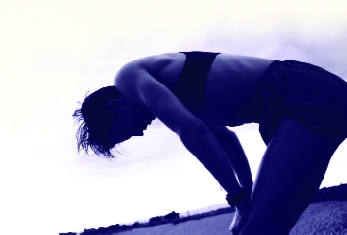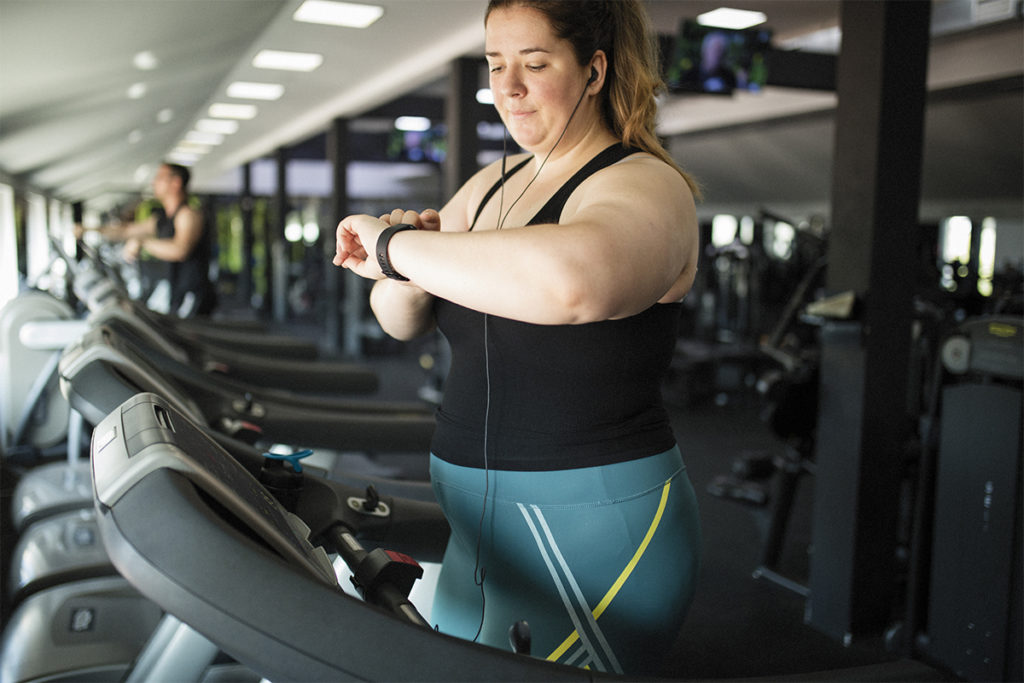Exercise-Induced Asthma
Recent research provides new insights into the triggers, symptoms and treatments of EIA.

Whether you train youth or seniors, competitive or recreational athletes, or physically gifted or challenged individuals, it’s quite possible that some of your clients have exercise-induced asthma (EIA). The findings from a recently published review article on EIA (Storms 2003) may provide the information you need to recognize this condition and find ways to help clients who suffer from its symptoms exercise safely and successfully.
What Is EIA?
The word asthma comes from a Greek word meaning “to pant.” Chronic asthma is the result of an inflammation in the passageways of the lung. This inflammation causes airway swelling, contraction of the smooth muscle surrounding the lung bronchioles, and mucous production—all of which can lead to dyspnea, or difficulty breathing. An asthmatic’s lungs are particularly sensitive to triggers such as dust mites, tobacco smoke, pollen, animal dander, cold air and environmental irritants. Symptoms can include coughing, wheezing, shortness of breath and chest tightness.
Individuals with exercise-induced asthma may exhibit many of the same symptoms as sufferers of chronic asthma, with the symptoms occurring during or after exercise. Some individuals with EIA may experience stomach pain, cramps and headaches as well as respiratory problems (Storms 2003). Many exercisers who note these symptoms just assume that the problem is simply that they are out of shape and thus do not seek medical advice. This is one reason it is so important for personal trainers to be vigilant in watching clients for respiratory symptoms during exercise and to encourage clients who experience these symptoms to consult a medical professional.
EIA sufferers can be divided into two categories. One group shows symptoms of asthma only during or after exercise. These clients do not react to any of the other triggers of chronic asthma. The second group has chronic asthma as well as EIA. For these individuals, exercise is just one of the factors that trigger asthmatic symptoms.
What Causes EIA?
Although the mechanisms of EIA are not fully understood, two current theories attempt to explain its pathogenesis. The hyperosmolarity theory proposes that water lost from the airway surface during exercise leads to the eventual release of pro-inflammatory mediators, which cause bronchoconstriction. The airway rewarming theory suggests that the hyperventilation that takes place during exercise cools the surface cells of the airways; then a rewarming of these airways after exercise causes bronchoconstriction. Neither of these theories considers inflammation the basic underlying mechanism of EIA (as it is with chronic asthma). However, recent research has demonstrated that inflammation is a factor with athletes who participate in cold-weather sports (Storms 2003).
EIA and Cold Weather
A surprising number of cold-weather athletes are particularly susceptible to postexercise respiratory symptoms compatible with EIA. Weiler and Ryan (2000), who evaluated the prevalence of asthma in athletes who participated in the 1998 Olympic winter games, reported that 22.4 percent used an asthma medication, had been diagnosed with asthma, or both. Similarly, in a study of ice hockey players, Leuppi and colleagues (1998) found that 19 percent were diagnosed with asthma and 11.5 percent with EIA; and in a study of figure skaters, Mannix and colleagues (1996) noted a 35 percent incidence of EIA. Many of the athletes studied had no prior personal or family history of asthma, and were able to exercise in warm weather without exhibiting symptoms (Storms 2003). A particularly important study by Wilber and colleagues (2000) found that the incidence of EIA in sports such as cross-country skiing was as high as 50 percent, compared to 23 percent for all athletes.
In addition, in a study of 40 cross-country skiers, Karjalainen and others (2000) found that the skiers not only had symptoms of EIA postexercise but also had evidence of chronic airway inflammation. This research suggests that these athletes are at higher risk of EIA due to their continued exposure to cold temperatures. Storms (2003) concluded, “In these athletes, there may [be] some chronic airway injury because of the inhalation of large volumes of cold air during training, which leads to findings that mimic true asthma.”
Although the symptoms that cold-weather athletes exhibit are often similar to those demonstrated by sufferers of chronic asthma, some studies have suggested that the same treatment may not be indicated. Sue-Chu and colleagues (2000) studied cross-country skiers with symptoms of EIA. Airway inflammation was detected in these skiers, but when treatment with inhaled steroids was prescribed, no beneficial effect was seen. Due to the lack of response to the usual asthma therapy in these skiers, the researchers suggest that the commonly reported symptoms of EIA in cold-weather athletes might, in fact, represent a separate condition from asthma and require a different treatment.
Treatment of EIA
For the recreational athlete the best treatment for EIA may be to simply avoid the activities most likely to cause asthma attacks. (See “Exercise Recommendations” on page 39.)
Another strategy is to warm up at approximately 60 percent of VO2 max, or 12 to 14 on the Borg rating of perceived exertion (RPE) scale (6 to 20 range), for 15 minutes before beginning formal exercise (McKenzie, McLuckie & Stirling 1994). A moderate-intensity warm-up has been shown to decrease the occurrence and severity of postexercise bronchoconstriction.
Medication may also be prescribed. Some individuals will simply take medication 10 to 15 minutes prior to starting exercise, while others will also take medication (i.e., steroids) for chronic asthma.
Of course elite athletes will find it more difficult than recreational athletes to avoid activities that commonly cause asthma attacks, since their goal is to compete in a specific sport. EIA need not prevent high levels of athletic achievement, however,
as is demonstrated by the number of successful Olympic athletes with this condition.
Exercise Recommendations
When training clients with asthma or EIA, you should take the following steps recommended by Nieman (1998) and others:
- Seek a physician’s clearance prior to
beginning an exercise program. - Become familiar with any medications
taken by your client and the possible
side effects. - Plan a dynamic warm-up of approxi-
mately 15 minutes at 60 percent VO2
max, or 12 to 14 on the RPE scale
(McKenzie, McLuckie & Stirling 1994). - If possible, recommend exercises that
are less likely to trigger symptoms of
EIA. Aquatic exercise is good because
the warm, humid air near the water
surface helps prevent the cooling and
drying of the lung airways. Exercising
indoors, as long as the air is unpolluted,
is generally preferable to exercising
outdoors. Stop-and-go sports and
team games like tennis and volleyball
are also less conducive to EIA for
some people (Storms 2003). - When practical, avoid exercises that
are most conducive to EIA. Outdoor
running is often regarded as the work-
out most likely to cause symptoms.
Next in line are treadmill running
and cycling. - When incorporating interval training
into an exercise program, show
prudence with the higher intensities. - Try a prolonged cool-down. Yoga may
enhance relaxation and exercise
tolerance (Vedanthan et al. 1998). - Teach clients to use slow nasal breathing
with low- to moderate-intensity exercise.(Breathing through the nose warms
and humidifies the air.) - Advise clients to wear a mask or scarf
over the face in cold weather to increase
the temperature and humidity of the
inhaled air, thereby reducing irritation
to the air passageways. - Closely monitor clients for any signs
of an asthma attack. - Avoid exercise environments that are
high in pollutants, pollen and other
asthma triggers (e.g., a recently mowed
grass field, an area with many flowers,
high-traffic roads). - In the case of an asthma attack, imme-
diately decrease exercise intensity. If
symptoms do not subside, seek medical
attention. - As with all clients, advise proper
hydration before, during and after
exercise.
All clients who have asthma and/or EIA should be made aware of the many benefits of physical activity, including:
- increased cardiorespiratory fitness
- increased work capacity
- improved exercise endurance
- reduced perception of breathlessness, or dyspnea
- reduced anxiety about physical activity
- possible alleviation of symptoms of bronchoconstriction
- possible decrease in the use of inhaled and oral steroids
References
Karjalainen, E.M., et al. 2000. Evidence of airway inflammation and remodeling in ski athletes with and without bronchial hyperresponsiveness to methacholine. American Journal of Respiratory and Critical Care Medicine, 161 (6), 2086-91.
Leuppi, J.D., et al. 1998. High prevalence of bronchial hyperresponsiveness and asthma in ice hockey players. European Respiratory Journal, 12, 13-6.
Mannix, E.T., et al. 1996. Exercise-induced asthma in figure skaters. Chest, 109 (2), 312-5.
McKenzie, D.C., McLuckie, S.L., & Stirling, D.R. 1994. The protective effects of continuous and interval exercise in athletes with exercise-induced asthma. Medicine & Science in Sports & Exercise, 26 (8), 951-6.
Nieman, D.C. 1998. The Exercise-Health Connection. Champaign, IL: Human Kinetics.
Storms, W.W. 2003. Review of exercise-induced asthma. Medicine & Science in Sports & Exercise, 35 (9), 1464-70.
Sue-Chu, M., et al. 2000. Placebo-controlled study of inhaled budesonide on indices of airway inflammation in bronchoalveolar lavage fluid and bronchial biopsies in cross-country skiers. Respiration, 67 (4), 417-25.
Vedanthan, P.K., et al. 1998. Clinical study of yoga techniques in university students with asthma: A controlled study. Allergy and Asthma Proceedings, 19 (1), 3-9.
Weiler, J.M., & Ryan, E.J. 3rd. 2000. Asthma in United States Olympic athletes who participated in the 1998 Olympic winter games. Journal of Allergy & Clinical Immunology, 106 (2), 267-71.
Wilber, R.L., et al. 2000. Incidence of exercise-induced bronchospasm in Olympic winter sports athletes. Medicine & Science in Sports & Exercise, 32 (4), 732-7.





